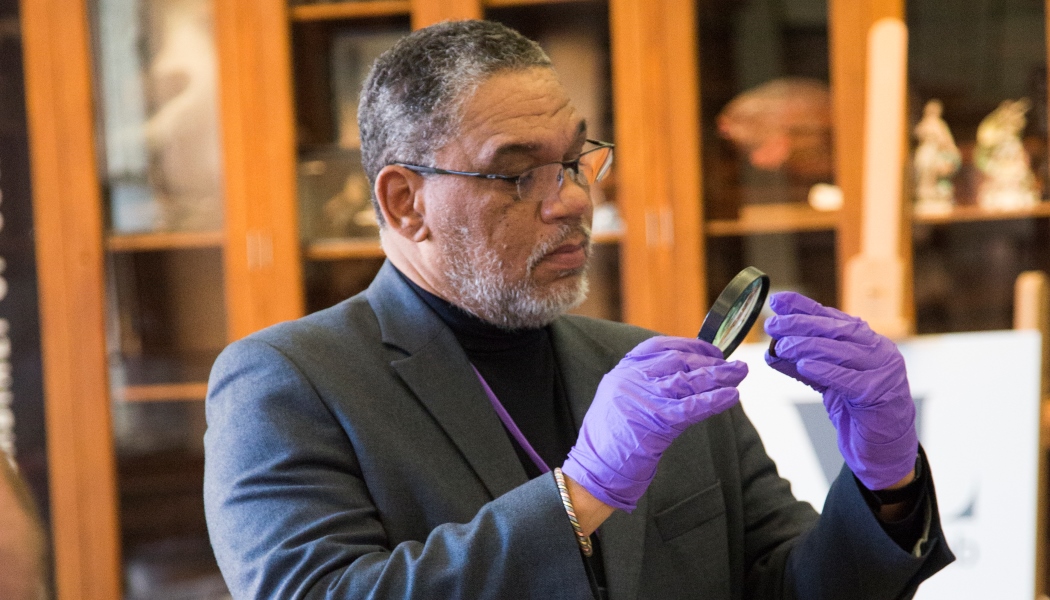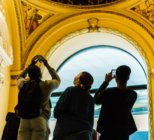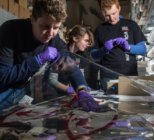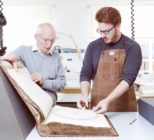The Workforce Development Programme (WDP) was established for permanent and casual frontline staff across RPM’s five venues: the Royal Pavilion, Brighton Museum & Art Gallery, Hove Museum, the Booth Museum of Natural History and Preston Manor.
It has created greater opportunities for staff to develop personally and professionally, and potentially move into new roles. Of three new RPM Collections Assistants recently appointed, two had taken part in the programme (and the third in RPM’s volunteering programme); while other participants have gained the confidence to set up their own business or develop further skills in other organisations.
The WDP part of RPM’s Arts Council England Major Partner Museum programme, which includes a sector leadership role in equality and diversity, to develop a skilled, engaged and entrepreneurial workforce.
Implemented by Learning and Engagement Manager Helen Graham, it has specific aims to:
- Develop skills among staff
- Support career progression among staff
- Contribute to the personal development of staff
- Bring new and fresh perspectives to RPM’s work
- Build ʻone teamʼ within the organisation
“Workforce development is incredibly important to Royal Pavilion & Museums (RPM) and the wider museum sector, particularly for front-of-house staff,” Helen Graham Learning, Engagement & Volunteer Manager Royal Pavilion & Museums. “It is often front-of-house teams that find it hard to get involved in other aspects of museum work, due to the public-facing nature of their posts. By offering a flexible programme of opportunities, our scheme allows them to take part in a range of placements that they otherwise wouldn’t get the opportunity to do.”
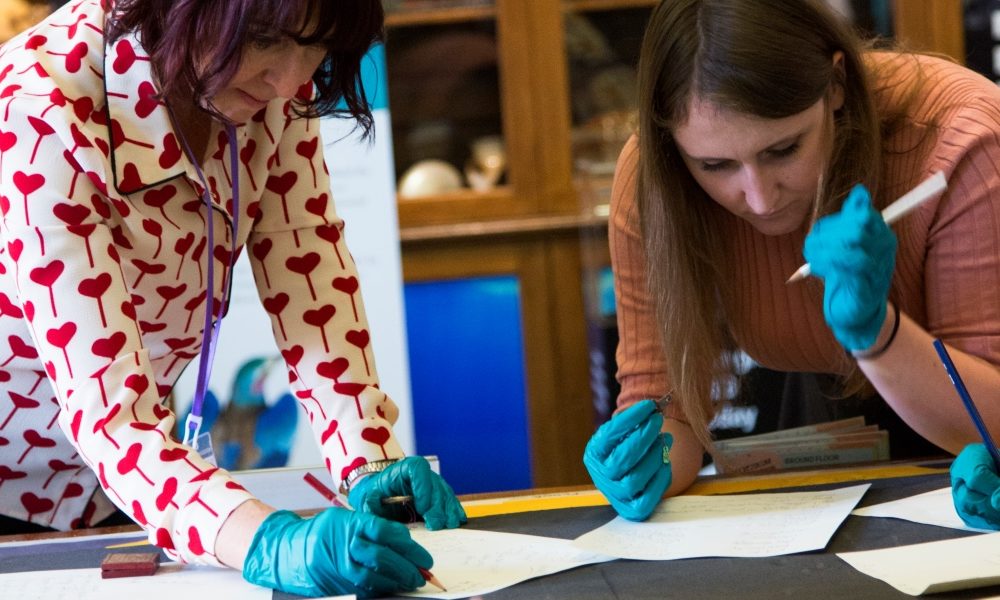
The importance of this kind of opportunity to the sector is fourfold she says; one, it is working with the most diverse part of the organisation, contributing to workforce diversity as front-of-house staff move into different roles both within and outside of their organisation; two, it encourages a sense of ‘one team’ across the organisation, as more staff work together in a more blended way; three, it allows for development by front-of-house staff, both personally and professionally – our recent evaluation shows that front-of-house staff report a greater level of confidence and self-esteem since being involved in other areas of the organisation, as well as increased skills and knowledge in specific areas; and, four, it increases the level of skills available to the organisation. For example, having three additional staff members trained in conservation means we now have a wider pool of people to call upon when needed.
“Approaching workforce development with this ethos moves away from the traditional museums view of everyone having one specific job role, towards a more flexible workforce.”
The key benefits of the scheme have been front-of-house staff being given more of a voice within the organisation around their own personal development and take the lead on a range of projects. RPM front-of-house staff are now involved in all aspects of the service, including conservation, gardening, collections care, planning and delivering exhibitions, displays and conferences, working in the bookings team, upkeep and maintenance of the buildings, community engagement and social media and marketing. This, says Graham, has given the organisation fresh perspectives across these areas, bringing new voices and ideas to their work.
“We’ve found that front-of-house staff are incredibly talented, creative and knowledgeable in all sorts of areas that are hidden during their usual roles, but come to the fore during their placements – they often bring ideas and knowledge that we were unaware we had within our own teams,” she says. “This has helped to create a one-team culture across the organisation, as we all work much more collaboratively than previously. We are seeing front-of-house staff successfully apply for other roles within the organisation as a result of their participating in workforce development, which brings with it a more diverse perspective and fresh ideas for the organisation.”
National Conference
The front-of-house staff are now trained in a number of new areas, which is beneficial both to those participating and to the organisation, and have seen major leaps in staff confidence and self-esteem. For example the front-of-house colleagues delivered the national conference on Workforce Development in November, with two of them giving the plenary at the conference. One of these staff members is going on to apply to participate in the Influence strand of the MA’s Transformers Programme.
At the national conference Graham said she was struck by the fact that all the museums seemed to be tackling Workforce Development differently, and that there hasn’t been a forum before to look into the topic. “Neither has there been a conference put on and delivered by front-of-house staff before. From listening to the talks and workshops with the attendees, we also seem to be the only organisation focusing our workforce development programme on the front-of-house team. As we are all doing it so differently, I would like to see some kind of network or learning sets established so we can talk more about this as a sector: what are we all doing and why, what is working/not working, and how are we evaluating our activities?”

At RPM there are also front-of-house staff working on the organisation’s engagement programme with its Museum Mentors group, for adults with critical social care needs. Their training to work with vulnerable adults has impacted positively on their front-of-house roles, and one member of staff is going on to study a Diploma in Social Care with a view to changing careers.
“The enhancement of staff skills has also worked the other way: managers who have supported a placement have also reported that they have increased their own skills as a result, learning to work in a different way, being challenged to think differently, and changing elements of projects accordingly,” she says. “In summary, there is no end to the skills enhancement we are seeing as a result of our workforce development programme.”
The WDP has encouraged diversity in the museums because the front-of-house teams are the most diverse part of the organisations and the programme puts them in a better position to apply for other jobs in the sector.
Flexible Workforce
One of the main aims of the scheme is to create a one-team culture, and this is helping the museums to create a more flexible workforce. Instead of having rigid posts people are skilled and knowledgeable in a wide range of areas, and these skills and knowledge can be used by the organisation in different ways to help create that flexibility. For example, having front-of-house people trained in conservation and collections care leads to a more flexible role for them, and a more flexible approach to job roles across the organisation going forward.
RPM is currently part of the local authority, which means it is not possible to determine whether the WDP has or will have an impact on recruitment but as it moves towards Trust status, Graham said she would hope to see a developing approach to recruitment building on current best practice.
One thing that is easily determinable, however, is whether or not the WDP is a nurturing scheme for staff. “Although it started life as quite a process-based scheme, it has evolved naturally to be more organic and supportive. Front-of-house staff now come up with their own ideas for what they would like to do, and we work with them to place them with the right team/project to realise this. I also provide a lot of one-to-one support for participants, and have used coaching skills to help them identify what they’d like to do career-wise and how we can help them using the scheme.” As a result of this RPM is currently recruiting a Workforce Development Officer post, to work with Graham to provide a stronger level of support and coaching for the front-of-house team. “This demonstrates our commitment to continuing to work with them to ensure the scheme continues to be nurturing and supportive, and can grow organically.”
Graham says she will be carrying out a further evaluation of the museums’ workforce development programme in the coming year, to gather more information from those who have participated in the last two years and look at where the scheme is and plan for the future. (They will also address some of the main challenges listed in the panel to the left.)
“The popularity of the programme is demonstrating that everyone has an opinion, more and more people want to get involved, and those who are involved don’t want their placements to end,” she says. “Fairness, inclusion and transparency are at the heart of the programme, so we need to ensure that all are involved in planning for the future.”
Ideas include rolling out the scheme to other staff groups, changing job specifications so that front-of-house staff can work more flexibly, and making the placements longer.
Q&A with Ruby McGonigle, Bookings Office & Retail Assistant at Royal Pavilion & Museums who has worked on the Workforce Development Programme
How has the Workforce Development Scheme benefitted your museums career and enhanced your skills both as a museum professional and in any other roles you undertake?
Being given the opportunity to work in Digital Marketing has allowed me to acquire and enhance skills in an area I’m really passionate about. I have not only been given an insight into what our Marketing team do to promote major exhibitions and events, learning a lot about the line of work, but have put some of those same techniques into practise myself.
I’m really appreciative of this opportunity and how it’s benefitted me. Before my Workforce Development placement I had only retail and front-of-house experience; now I have knowledge of, and experience in, a new field altogether. Moving forward this will benefit my museums career, because I can be of help in a much broader range of roles than before. I also dream of becoming a journalist one day, so experience in writing for public-facing and promotional purposes will be a really valuable asset.
What benefits do you feel the scheme has brought, through staff, to the services the museums provide visitors?
The scheme’s opportunities to move between roles and departments allow staff to develop a wealth of knowledge that’s much broader than if they are bound to just one role, venue or team. Acquiring new skills and gaining insights into how different areas of the organisation work means that staff are much more competent, knowledgeable and confident when it comes to answering customer enquiries. Relaxing the boundaries between teams makes for much less disparate groups and areas of knowledge, which I think results in a far smoother and more seamless service for visitors.
Do you have a sense of the benefits the scheme has brought to the museums as a whole?
Just speaking to fellow colleagues about their experiences of Workforce Development has given me a clear sense of how beneficial the scheme is overall. Staff are more confident in themselves and their abilities at work, feel enriched by their new knowledge and experiences, and are inspired to take their new skills into directions they perhaps might never have thought of before. People also feel more valued, as they are offered more opportunities than before and given the chance to get involved in things that they really enjoy and are passionate about. These views were highlighted brilliantly by our Workforce Development conference in November 2016, and I feel that this shift in attitude in frontline staff can only have a positive impact on our museums as a whole.
Challenges for the Workforce Development Programme
Demand and expectation
Staff have expressed an overwhelming enthusiasm for the programme to continue, and a growing demand is evident. The programme is almost becoming a victim of its own success; how can we ensure we have the infrastructure to continue to support the programme to grow? How do we manage people’s expectations? It is also often difficult to release front-of-house staff from their main role, particularly in the busy summer season – the more staff want to participate, the more difficult this becomes.
Further progression
Many staff ask the question ‘what next?’ How can staff build upon their WFD experience? Are there any next steps that can be built into the programme? Suggestions made by staff in response to this question include appointing mentors to support WFD participants, and offering post-placement exit interviews and careers advice. This is something that will be picked up in our evaluation, and will also be addressed through our new Workforce Development Officer post.
Equal opportunity
Staff have expressed concerns about the distribution of Workforce Development opportunities: some staff members can be seen as doing more than others, and some placements are being extended. There have also been a number of requests that other staff groups should be able to take part in the programme.
- Staff have felt frustrated about their return to their usual job role after participating.
- Fluidity v structure
As the programme has evolved organically its ambition has outgrown current structures, which are struggling to support the programme. Although there are many benefits to the programme being fluid, we need to consider if this works for the organisation. Would a more structured approach be better? Or can we find a balance between structure and fluidity?

